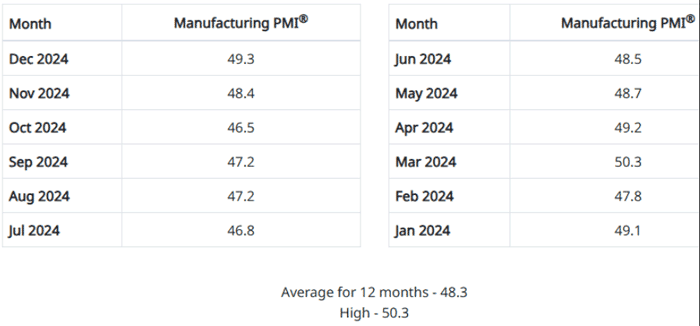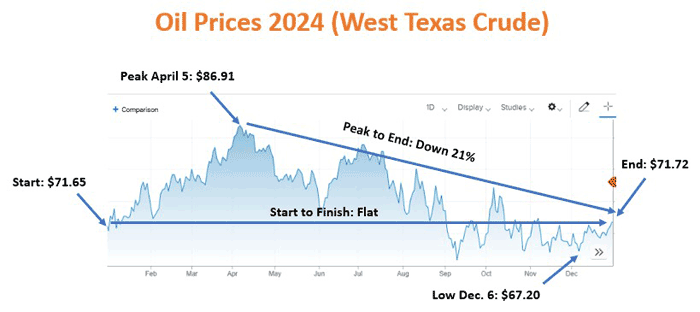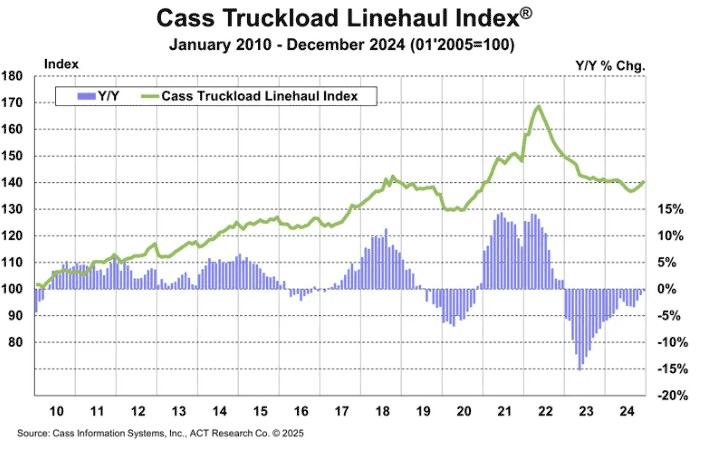I am continuing our review of the year in supply chain 2024 after covering the top stories by month last week and last week offerng a look at the performance of our supply chain stock index.
This week, we we cap it off with our popular look at 2024 in numbers and charts
Gilmore Says.... |
 |
At index level of 99.3, it means US manufacturing output is just below the baseline year of 2017 levels (index = 100) now 8 long years later.
|
 |
What do you say? |
|
| Click here to send us your comments |
| |
|
|
|
We always start with a check on the US and global economy, as that has such an impact in the end on supply chain practice.
In Q1 we saw real GDP growth of a weak 1.4%, but then it jumped to 3.0% and 3.1% in Q2 and Q3, respectively, according to the Commerce Dept. Q4. Full year numbers should be released any day. Growth for all of 2024 should come in a little under 3%, meaning the US will not hit that target again since 2005, excepting 2021 coming off a big COVID-driven decline the previous year.
On a global basis, the International Monetary Fund (IMF) last week kept its 2024 global real gross domestic product growth forecast unchanged at 3.2%, versus a 3.7% average from 2000 to 2019. It predicts global growth of 3.3% for 2025.
The IMF forecast US GDP came in at 2.7% growth for 2025, compared to 4.6% for China.
One measure of the health of the US manufacturing sector is the US Purchasing Managers Index from the Institute of Supply Management. As shown below, the PMI has been below the key 50 mark that separates US manufacturing expansion from contraction for 11 out of 12 months.
US PMI 2024

Source: ISM
So it’s mixed signals on the economy, with decent but not strong growth, while the PMI indicatates a prolonged manufacturing slump.
Another view of US manufacturing strength is the mnthly index on US factory output from the Federal Reserve.
The index for December came in at 99.3, and indeed it hovered around that 99 level for all of 2024. However, the December score is still well below the 105 level reached in February 2020 right before the COVID crisis.
In fact, at index level of 99.3, it means US manufacturing output is just below the baseline year of 2017 levels (index = 100) now 8 long years later.
Switching gears, it was flat year for oil prices in total in 2024. At the start of January crude was $71.65 per barrel, and it went mostly up from there until early April ($86.91). It was mostly down for the rest of the year, with prices ending the year almost exactly where they started:

US on-the-road diesel prices were flat, starting the year at $3.87 per gallon, and ending the year at $3.50, with a peak of $4.10 in February.
Freight volumes were mixed but mostly down. The Freight Tonnage Index from ATA fell modestly versus 2023. In November, the index was up 1% from a year earlier, which was the first year-over-year monthly gain since February 2023. The full index reading for December was 111.3, versus the baseline of the average month in 2015 (index = 100), meaning 10 years later US freight tonnage is only up 11.3%. However, some are citing growing levels of private fleets taking on third-party transport business as a factor in declines for commercial carriers.
The Cass Linehaul Index, which tracks per mile truckload contract rates in the US before any fuel surcharge or other accessorial fees, has been down year-over-year since mid-2022, though the rate of decline has slowed, as seen in the chart below. The index is now almost back to mid-2020 rate levels.

Source: Cass
It was a decent first half for US railroads. Total combined US carload and intermodal traffic for 2024 was 25.1 million, an increase of 3.4% compared to 2023. Carloads were down 2.9%, while intermodal cars were up 9.3%.
Ocean container shipping rates soared after so-call Houthi-rebels started firing missiles at cargo ships and forced carriers to abandon sailing through the Red Sea and Suez Canal, taking the long way around southern Africa instead. Rates from China to the US East Coast soared to almost $10,000 by end of June, nearly double the cost in February. The China Containerized Freight Index, which tracks overall ocean rates out of China, started the year at $2000, rose to about $2100, but then started falling, ending the year at about $1500.
US ecommerce sales were up 7-8% in each of the first three quarters of 2024 versus 2023, above the overall US retail sales growth of 1.5-2.1%. eCommerce sales as a share of total retail remained at 15-16%, by the way the Census Bureau measures it, where it has stayed for some time.
I have lots more but am out of space. Hope you enjoyed all this.
What is your reaction to the year in supply chain 2024 in numbers and charts? What numbers would you add? Let us know your thought at the Feedback section below:
Comments/Feedback
|